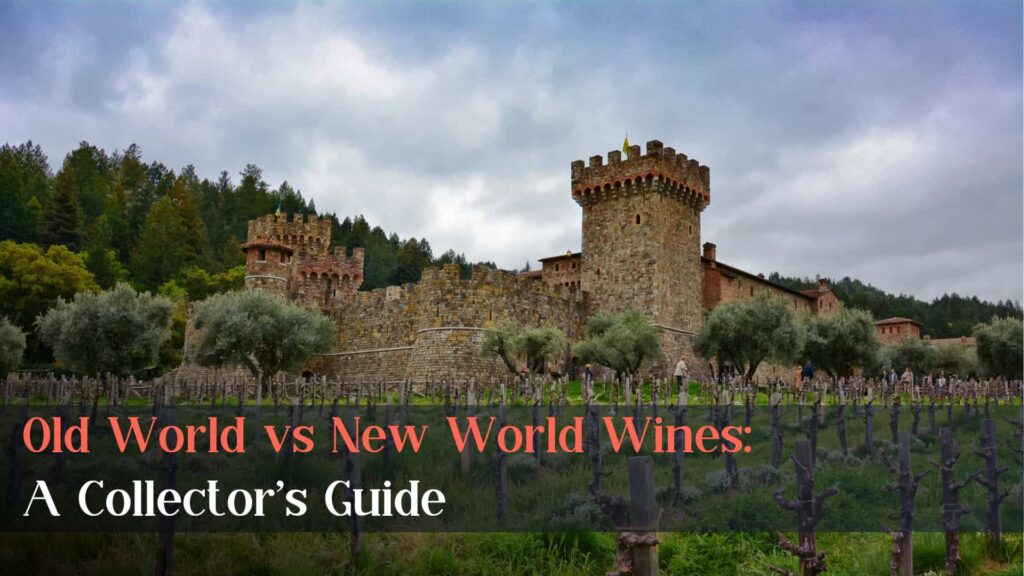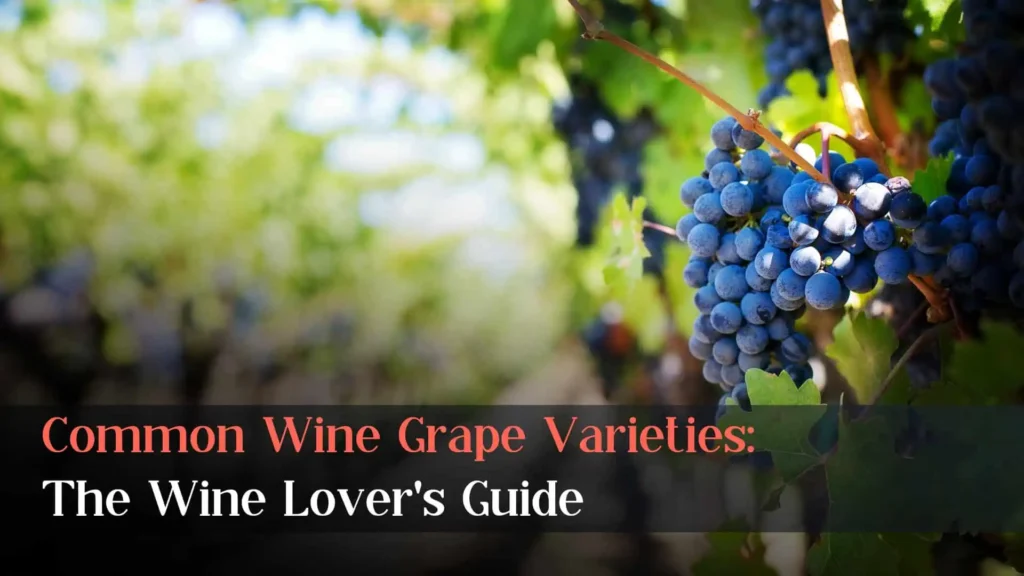The world of wine is often divided into two camps: Old World and New World. But what do these terms mean, and do they still matter in today’s global wine market?
From the storied vineyards of France to the innovative wineries of California, let’s explore the characteristics, differences, and evolving nature of Old World and New World wines.
Historical Context of Old World & New World Wines
The terms “Old World” and “New World” in wine originated from geographical and historical perspectives:
- Old World: Refers to traditional wine-producing regions in Europe and the Middle East, where winemaking has been practiced for thousands of years. Countries like France, Italy, Spain, and Germany are prime examples.
- New World: Encompasses wine regions established by European colonization, primarily in the Americas, Australia, New Zealand, and South Africa. Large-scale wine production in these areas began in the 16th-17th centuries.
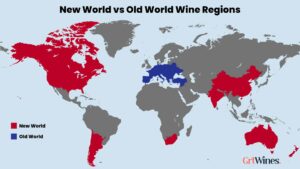
This distinction emerged as wines from newer regions began to gain recognition in the global market. While Old World wines were steeped in centuries of tradition and strict regulations, New World wines offered a fresh approach, often with more flexibility in grape varieties and winemaking techniques.
Over time, these differences shaped distinct winemaking philosophies, influencing everything from grape selection to production methods and flavor profiles.
Table of Contents
ToggleOld World Wines
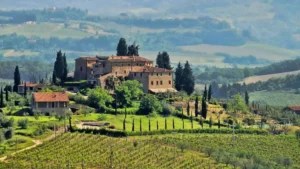
Old World wines are steeped in tradition, with winemaking practices honed over centuries. These wines are typically associated with European countries and are known for emphasizing terroir and traditional wine-making techniques.
Old World Key Regions
- France: Home to renowned regions like Bordeaux, Burgundy, and Champagne.
- Italy: Famous for Tuscany (Chianti), Piedmont (Barolo), and Veneto (Prosecco).
- Spain: Notable regions include Rioja, Ribera del Duero, and Priorat.
- Germany: Known for its Rieslings from regions like Mosel and Rheingau.
- Portugal: Famous for Port wine from the Douro Valley.
Characteristics and Winemaking Philosophy of Old World Wines
Old World wines are renowned for their focus on terroir – the environmental factors that affect a crop’s phenotype, including unique aspects of the growing site, such as soil, weather, and sunlight.
This emphasis on terroir often results in wines that are expressive of their specific place of origin. Old World winemakers typically aim to create wines that are balanced and subtle, with an emphasis on structure and acidity rather than fruit-forward flavors.
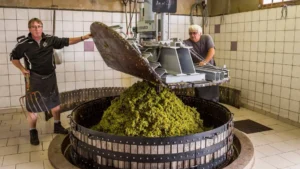
The winemaking philosophy in Old World regions often leans heavily on tradition, with many practices handed down through generations.
These wines tend to be lighter-bodied with higher acidity and lower alcohol content compared to their New World counterparts. The use of oak is generally more restrained, allowing the natural characteristics of the grapes and terroir to shine through. This approach often results in wines that are considered more food-friendly and age-worthy.
Notable Old World Grape Varieties
- Red: Cabernet Sauvignon, Merlot, Pinot Noir, Sangiovese, Tempranillo
- White: Chardonnay, Riesling, Sauvignon Blanc, Pinot Grigio
Regulatory Systems
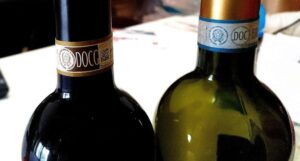
Old World wine regions often have strict regulations governing wine production, such as the 3 classification systems below:
- France: Appellation d’Origine Contrôlée (AOC)
- Italy: Denominazione di Origine Controllata (DOC)
- Spain: Denominación de Origen (DO)
These systems control aspects like grape varieties, yield limits, and winemaking practices to maintain regional distinctiveness and quality standards. To learn more about wine classifications check out our post below:
Related Post: What’s in a Name? The Meaning of Cru in Fine Wine
New World Wines
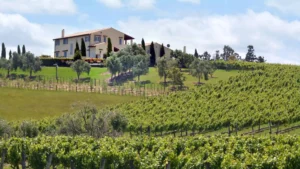
New World wines are characterized by innovation, experimentation, and a focus on grape varieties over specific terroir. These wines come from regions where viticulture was introduced relatively recently, often by European settlers.
Key Regions
- United States: Primarily California (Napa Valley, Sonoma), but also Oregon and Washington
- Australia: Notable regions include Barossa Valley, Margaret River, and Hunter Valley
- New Zealand: Famous for Marlborough Sauvignon Blanc and Central Otago Pinot Noir
- Chile: Known for its Cabernet Sauvignon and Carmenère
- Argentina: Renowned for Malbec, especially from Mendoza
Characteristics and Winemaking Philosophy
New World wines are characterized by their fruit-forward flavors and emphasis on varietal expression. Winemakers in these regions often focus on highlighting the primary fruit flavors of the grape, resulting in wines that are bold, ripe, and intensely flavored. New World wines tend to be fuller-bodied with higher alcohol content due to warmer climates and extended ripening periods.
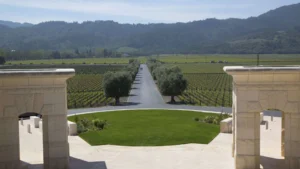
The winemaking philosophy in New World regions embraces innovation and experimentation. Winemakers are more likely to use modern technology and techniques in both the vineyard and the winery. They often have more flexibility in their approach, as they are less bound by traditional practices or strict regulations.
This freedom allows for creative blending, the use of non-traditional grape varieties, and the adoption of sustainable and organic practices. The result is often a more diverse range of wine styles, from classic expressions to unique, pioneering blends.
Notable Grape Varieties
- Red: Cabernet Sauvignon, Merlot, Shiraz/Syrah, Malbec, Zinfandel
- White: Chardonnay, Sauvignon Blanc, Pinot Gris
New World Wine Labeling Practices & Innovations
Unlike the strict classification systems of the Old World, New World wines typically use a more straightforward labeling approach. Wines are often labeled by grape variety, making it easier for consumers to understand what’s in the bottle. This varietal labeling practice, pioneered by New World producers, has since influenced some Old World regions to adopt similar consumer-friendly approaches.

While regulations exist, they are generally less stringent than in Old World regions, allowing for greater flexibility and experimentation in winemaking practices, leading to further innovations like:
- Sustainable Viticulture: New World regions have been at the forefront of implementing large-scale sustainable and organic vineyard practices, with initiatives like New Zealand’s aim to have 100% of its vineyards operating under independently audited sustainability programs.
- Screw Cap Adoption: Australian and New Zealand producers led the charge in the widespread adoption of screw caps for premium wines, challenging traditional cork closures and reducing the incidence of cork taint.
- Temperature-Controlled Fermentation: New World winemakers pioneered the use of temperature-controlled stainless steel tanks for fermentation, allowing for precise control over the fermentation process and resulting in fresher, more fruit-forward white wines and aromatic reds.
Blurring the Lines
While the Old World vs New World categorization remains useful, the distinction is becoming increasingly blurred in today’s global wine industry. This convergence is driven by several factors:
- Knowledge Exchange: Modern winemakers frequently gain experience in both Old and New World regions, leading to a cross-pollination of ideas and techniques.
- Evolving Traditions: Old World regions are embracing modern technologies and experimenting with non-traditional grape varieties. Examples include “Super Tuscans” in Italy and modern-style Riojas in Spain.
- Terroir Focus in New World: New World regions are placing greater emphasis on expressing unique regional characteristics. Napa Valley’s single-vineyard wines and Australia’s cool-climate Shiraz showcase this trend.
- Sustainability: Both Old and New World winemakers are increasingly adopting organic and biodynamic practices, recognizing the importance of environmental stewardship.
- Climate Change Adaptation: Winemakers globally are experimenting with heat-resistant grape varieties and exploring new wine-growing regions in cooler climates.
This convergence is creating exciting new wines that combine Old World tradition and terroir expression with New World innovation and bold flavors. As a result, wine enthusiasts today can enjoy a more diverse and dynamic range of wines that showcase the best of both worlds.
Collecting and Enjoying New & Old World Wines
Whether you’re a seasoned collector or a curious newcomer, exploring both Old and New World wines can be a delightful journey. Here are some tips to enhance your wine collecting experience:
Start by familiarizing yourself with the classics. Try benchmark wines from renowned Old World regions like Bordeaux or Tuscany, and compare them with famous New World offerings from areas like Napa Valley or Barossa. This will give you a solid foundation for understanding the traditional differences between Old and New World styles.
To deepen your understanding, try comparing the same grape variety from different regions. For example, taste a Syrah from the Northern Rhône alongside a Shiraz from Australia. This side-by-side comparison can highlight the influence of terroir and winemaking philosophy on the final product.
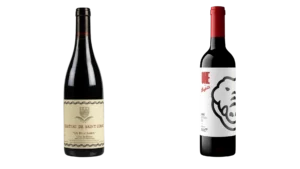
Once you’ve explored the well-known regions, you can start to venture into lesser-known territories. Both the Old and New World have emerging wine regions that offer exciting discoveries, often at more accessible price points.
When tasting, consider the context of each wine. Pay attention to structural elements like body, acidity, and tannins, which can often provide clues about whether a wine is Old World or New World in style.
Here are a few more things you can do to further enhance your exploration of New and Old World wines:
- Attend tastings or join a wine club to expand your palate and knowledge.
- Experiment with food pairings, trying both traditional and unexpected combinations.
- Learn about aging potential – understand which wines benefit from proper storage and which are best enjoyed young.
Remember, there’s no right or wrong in wine preferences. The joy is in the exploration and in finding the wines that speak to your personal taste.
Whether you lean towards the subtle complexity of Old World wines or the bold expressiveness of New World wines, there’s a whole world of flavors waiting to be discovered.
Leveraging Technology
Digital platforms like GrtWines make it easier than ever to access and collect a wide variety of wines from both Old and New World regions.
These platforms often provide detailed information about each wine’s origin, winemaking process, provenance, and tasting notes, allowing you to further enhance your appreciation and understanding.
Conclusion: Embracing the Best of Both Worlds
The distinction between Old World and New World wines, while rooted in history and geography, is becoming increasingly nuanced in today’s global wine landscape. Both categories offer unique strengths:
As we’ve seen, the lines between these two worlds are blurring, with winemakers around the globe adopting practices from both philosophies to create exciting, high-quality wines.
For wine enthusiasts, this convergence presents an opportunity to explore a vast and diverse world of flavors and styles. Whether you prefer the subtle complexity of a Burgundy Pinot Noir or the bold richness of a Napa Valley Cabernet Sauvignon, there’s never been a better time to be a wine lover.
